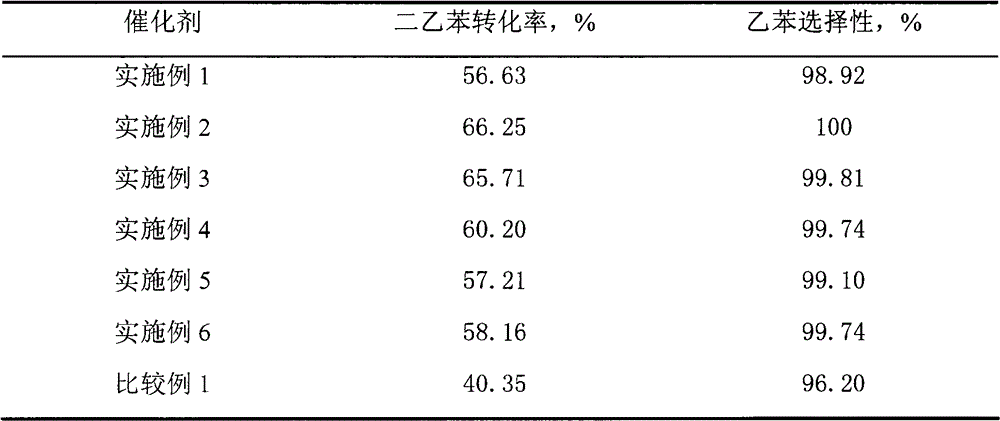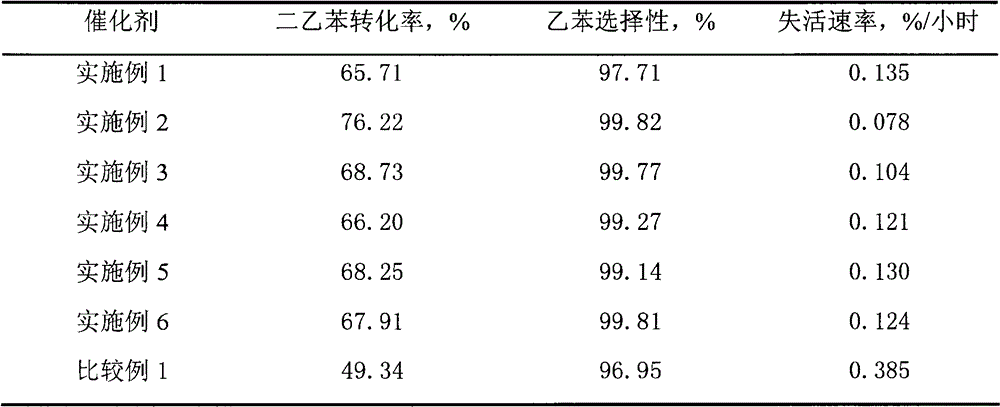Method for production of ethylbenzene through liquid phase transalkylation of polyethylbenzene and benzene
A polyethylbenzene, transalkylation technology, applied in chemical instruments and methods, hydrocarbons, molecular sieve catalysts, etc., can solve the problems of poor catalyst stability, low ethylbenzene selectivity, and short regeneration cycle.
- Summary
- Abstract
- Description
- Claims
- Application Information
AI Technical Summary
Problems solved by technology
Method used
Image
Examples
Embodiment 1
[0023] Weigh 100 grams of deionized water and pour it into a polytetrafluoroethylene cup. Then weigh 14 grams of sodium metaaluminate solid and dissolve it under stirring. After the sodium metaaluminate is completely dissolved, add 8 grams of NaOH to dissolve. Then weigh 120 grams of tetraethylammonium bromide, and dissolve it in a polytetrafluoroethylene cup with stirring. After all dissolved, 300 g of 40% silica sol was added under vigorous stirring. Finally, 80 grams of deionized water was added. After stirring for half an hour, it was transferred to a crystallization kettle for dynamic crystallization at 150°C for 3 days. Slurry, filter and wash with deionized water to a pH of less than 10. Finally, it was dried at 110°C for later use.
[0024] Weigh 50 grams of the above-prepared zeolite beta raw powder, and add it into the prepared aqueous sodium hydroxide solution with a weight concentration of 0.1%. Stir with a magnetic stirrer for 5 hours at 95°C, centrifuge, fi...
Embodiment 2~6
[0027] With [embodiment 1], only the condition of alkali treatment in the process is different. See Table 1 for details.
[0028] Table 1
[0029]
Embodiment 7
[0031] The catalyst activity was examined in a fixed-bed reactor from bottom to top, and the reactor was a stainless steel tube with an inner diameter of 28 mm and a length of 800 mm. The catalyst load was 6 grams and diluted with glass beads.
[0032] After loading the catalyst of [Example 1-7] into the reactor, the catalyst was activated under the protection of nitrogen, and activated at 400° C. for 1 hour. Then cool to below 40°C, stop nitrogen purging, start to feed the transalkylation material, and start to heat up to the reaction temperature after the pressure reaches the set value.
[0033] The reaction conditions are: temperature 220°C, pressure 3.0MPa, total liquid space velocity 2 hours -1 , The weight ratio of benzene to diethylbenzene is 8:1. After the system was stabilized, the liquid product was taken regularly for chromatographic analysis. The following data are the stable data of feeding for 10 hours, see Table 2 for details.
PUM
| Property | Measurement | Unit |
|---|---|---|
| The inside diameter of | aaaaa | aaaaa |
| Length | aaaaa | aaaaa |
Abstract
Description
Claims
Application Information
 Login to View More
Login to View More - R&D Engineer
- R&D Manager
- IP Professional
- Industry Leading Data Capabilities
- Powerful AI technology
- Patent DNA Extraction
Browse by: Latest US Patents, China's latest patents, Technical Efficacy Thesaurus, Application Domain, Technology Topic, Popular Technical Reports.
© 2024 PatSnap. All rights reserved.Legal|Privacy policy|Modern Slavery Act Transparency Statement|Sitemap|About US| Contact US: help@patsnap.com










